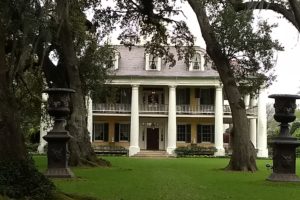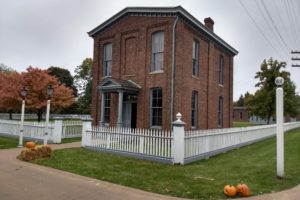This stop was actually our last one while we were in Charleston. Everywhere we’d been was crowded and busy, and we were a little over whelmed. We thought you might like a break from looking at war that we’ve been seeing. Visiting a tea garden outside of the city sounded like heaven to us–and it was. We had always thought that tea was grown in India and China, never in the U.S. So we had a lot to learn, and I bet you do too–even if you’re not a tea drinker.





We weren’t quite sure what they would look like.


tea in South Carolina
In the late 1700s, tea bushes, known as Camellia Sinensis, first arrived in the United States from China when French botanist Andre Michaus brought plants to an area he owned on the Ashley River that borders Charleston. He never attempted large-scale production. Others tried growing tea plants after that, but no one ever succeeded. In the 1800s, the U.S. Congress subsidized renewed cultivation efforts.
In 1888, Dr. Charles Shepard founded the Pinehurst Tea Plantation near Michaux’s original planting. A variety of tea known as Oolong was its claim to fame, and it even won first prize at the 1904 World’s Fair.


Much later, in 1963, the Thomas J. Lipton company established a research station on Wadmalaw Island (where we are today), bringing 127 cuttings from Pinehurst and staff hand-planted 25,000 plants. Because these plants had grown wild and cross-pollinated for decades before coming here, they are now considered “South Carolina Hybrids.”
The research facility operated for 25 years and proved that a high-quality tea could be grown commercially in South Carolina.
In 1987, Mack Fleming, a manager at Lipton, and his partner Bill Hall, a third-generation tea taster trained in England, purchased the 127-acre tea farm and created the Charleston Tea Plantation. Together, they created the brand known as American Classic Tea, which is still blended today. Their partnership dissolved in 2003, and the property ended up at auction where it would most likely have fallen into the hands of developers. Seeking additional financing, Bill reached out to his longtime friends, the Bigelow family. A partnership arrangement was worked out, and the Bigelow Tea Company, a Connecticut-based company with products in almost every American grocery store, bought the garden.

The company continues to grow and sell Fleming and Hall’s original blend, American Classic Tea, and it remains the only black tea produced commercially in the United States.
Since 2003 the Charleston Tea Garden has become a true American icon. American Classic Tea has maintained its faithful fans since its start in the late 1980s, and thanks to Bill Hall’s creativity, many new teas have been added under the Charleston Tea Garden brand. Hope you look for it in your local grocery store; here’s what it looks like.


On June 9, 2020, the name of this tea farm was changed to the Charleston Tea Garden. This land has been farm country for decades, so now the name represents the land. Thanks to the Bigelow Family, the working tea farm offers a learning experience unlike any other in the country.
Tea is South Carolina’s “Official Hospitality Beverage.” In 1995, South Carolina’s General Assembly determined that since tea is the “world’s most popular beverage” – besides water, of course – it should serve as the state hospitality beverage. The law was soon ratified, making this an official drink of the state.
(History information taken from the Charleston Tea Garden and History of South Carolina Tea Farms websites.)
tea leaves to tea
Inside the Tea Garden’s store is a complimentary all-you-can-taste tea bar with hot or iced tea that has been made here. The store also has a factory tour that looks out on the production floor.








CTC (Crush, Tear, and Curl or Cut, Tear, and Curl) is a method of processing tea in which tea leaves are passed through a series of cylindrical rollers with serrated blades that crush, tear, and curl the tea into small, even-shaped pellets.
Immediately after being harvested and cleaned, the leaves of green tea are heated in order to halt the oxidation process. The leaves for black tea go through the rest of this process.


trolley ride through the tea fields




When harvesting, every 15-18 days, only the new shoots on the plants are cut off and taken into the shed for processing. Tea plants need 1″ of water each week (52″ each year). Irrigation from ponds on the farm help out if rain doesn’t come regularly. The only threat to tea plants is too much water. They are immune to insects. Plants can grow for hundreds of years, and they are never dug out or replaced since their branches and roots are intertwine with other plants. They’re planted like a pine tree crop in rows with spacing between them. Prior to each harvesting, the field is weeded manually.


A plant’s character of tea is based on its growing location. This location is farm land that hasn’t known manufacturing or overcrowding. The tea tree grows best in a tropical and subtropical climate with plenty of rain, minimum of 60″ a year, and a dry season that lasts no more than 3 months. The ideal average temperature is around 68 degrees F, with a minimum of 5 hours of sunshine and a relative humidity of 70% to 90%. Sounds like this area of South Carolina.
greenhouse
To add new fields, new tea plants are propagated with cuttings from existing plants, keeping them in a climate-controlled greenhouse until they are mature enough to survive outdoors. The greenhouse uses such technology as watering systems, shade panels, temperature and humidity controls, swamp coolers, and heating tubes.






The first iced tea was served at the 1904 World’s Fair in St. Louis. It was so hot that day that they decided to cool off their patrons by putting ice in the hot tea. It was a success.

Here’s information about this FrankenTractor:
“A tea plantation of this size would normally require 500 people to hand pick the tea leaves. This unique harvester allows one person to gently pluck all those leaves from the ‘comfort’ of the cab. So with everything becoming automated these days, (and tea being the second most popular drink after water), why aren’t other tobacco harvester/cotton picking Franken-machines flying off the shelves and finding homes on other tea plantations around the world? In places like Indonesia, China, Sri Lanka and India each tea leaf is still hand picked!” The reason, in other tea growing places the plants are on uneven terrain.
“A machine like the green giant would never be able to delicately chop just the top few inches off the tea plants. But since the Charleston Tea Plantation is on flat coastal land, the green giant works perfectly here. It’s even trusted to harvest the coveted “first flush,” which is the first harvest of the year (usually in April or May) when the new tender spring growth provides an exceptionally mellow tea.”
If you’re wondering how much caffeine is in a cup of tea and coffee, here’s the average milligrams of caffeine per tea bag:
- coffee : 100-120 mg
- black tea: 30-60 mg
- green tea: 25-50 mg
Usually, green tea has less tea per bag and so less caffeine. But the caffeine levels vary based on climate and soil content since we’re talking about a natural occurring part of the plant.
While we were on the trolley tour, our guide mentioned that we should go see the Angel Tree. So we did.
Angel oak tree


This is considered to be the largest Live Oak Tree east of the Mississippi, estimating to be 300 to 400 years old.

It has approximately 400,000 visitors each year. The tree is 65′ high with a circumference of 25.5 feet, shading an area of 17,000 square feet. The public can see it up close 7 days a week.




Now that we’ve had a breath of fresh air, let’s go explore other times in our military’s history at Patriot’s Point in Charleston.




